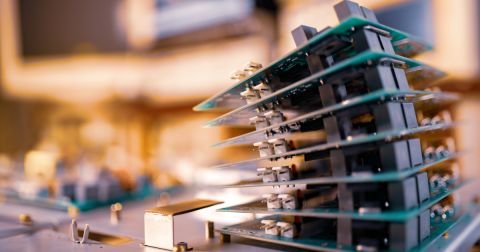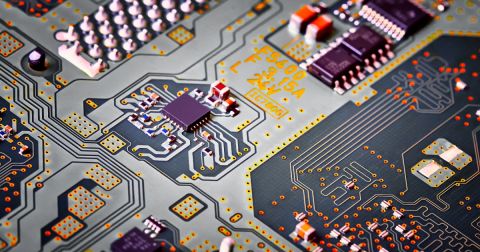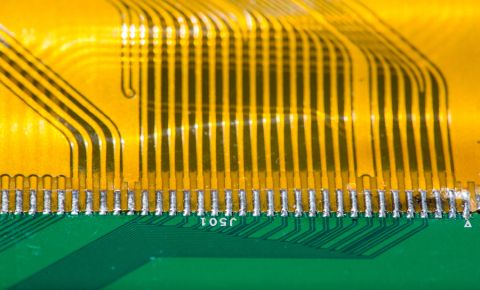Altium Designer: The Best PCB Design Software

Everyone from engineering students to PCB design professionals want the same things: an easy-to-use yet powerful set of electronics design tools that help speed up the pace of innovation. PCB designers create important pieces of hardware that requires specialized software to design, lay out, and prepare for production. When you need the best design tools the market can offer, what features should you look for and how can you ensure you accelerate your design process?
Altium's design toolset has always championed ease-of-use and productivity above all other aspects to ensure designers have the best possible PCB design experience. Keep reading to see what features you can expect in the best PCB design software to help you build advanced electronics successfully.
ALTIUM DESIGNER
The best professional circuit design software and PCB design software.
PCB design software is built to help you follow a specific workflow that eventaully gets a product into fabrication and assembly. The PCB design process drives the workflow implemented in PCB design software, and it requires a specific set of features be included in these design tools. While the bare basics are important, the best PCB design software will have more advanced features that help you stay productive and design successfully.
A Schematic Editor Gives You a Strong Foundation
All circuit board designs start with a set of schematic sheets that contain all components and electrical connections between components. Successful schematic capture in professional circuit design software includes an important set of features to ensure your design is complete and has sourceable parts:
- Circuit drawing features that include schematic symbols
- Instant access to all your component libraries inside the schematic editor
- Back-annotation features that update schematics and unknown designators
- A generic component library that can be used to build high-level diagrams or simulations
- An integrated SPICE package for circuit simulation and evaluation
- Access to supply chain data linked directly to your parts libraries
Most PCB design applications do not include the part search features that can help you find components with available CAD data, as well as sourcing information for every component in your design. All of these features can help you stay productive as you build advanced electronics technology for nearly any applicaiton.
Find the Parts You Need in the Manufacturer Part Search Panel
To help you quickly find and use components to build your PCB, Altium Designer includes the Manufacturer Part Seach panel integrated into its world-class schematic editor. Many of the components in the Manufacturer Part Search panel include CAD data that is verified by component vendors, so you can quickly import these components into your schematics with matching footprints. The sourcing data you pull from the Manufacturer Part Search panel will be automatically ported into your bill of materials, and sourcing data can be managed using the ActiveBOM system.
- Altium Designer's schematic editor includes a set of parts selection features that help you quickly create circuits and high-professional schematics.
Learn more about creating circuits and schematics in Altium Designer.
- For complex electronics systems, Altium Designer implements hierarchical multi-channel design featuers that keep you organized and ease design reuse.
Learn more about hierarchical schematics in Altium Designer.
- The schematic editor in in Altium Designer’s includes a SPICE simulation package that implements industry-standard circuit simulations and analysis. There's no need to export your design to an external circuit simulation tool when you use Altium Designer.
Learn more about running SPICE simulations in Altium Designer.

The Best Features Professionals Demand in a PCB Editor
Professional designers need a suite of CAD tools that are uniquely tailored to designing the features you'll see in a PCB. Standard drawing tools simply won't do the job, CAD users need an easy-to-use PCB editor to help them work at maximum productivity. Some of the major features designers demand include:
- The best CAD features that allow you to quickly place and route components in a PCB layout
- A routing engine that easily semi-automates single-ended and differential pair routes between components
- Deliverables creation features that generate manufacturing files in standard formats
- Advanced routing features that enforce impedance targets, via sizes and templates, and per-layer routing rules
- Cross-probing features to instantly access information in the schematic
- An online DRC engine that catches errors and flags them visually in the PCB layout
- A layer stack design tool that enables material selection and layer definitions, as well as impedance calculations
- Multi-board PCB design features with 3D modeling capabilities built into the PCB editor
The layout and routing features in Altium Designer include an additional set of features that automate important design decisions, such as application of teardrops, via stitching, polygon management, placement of 3D bodies, and comprehensive modeling of flex/rigid-flex circuit boards in the PCB layout.
How Altium Designer Keeps You Productive
Altium's focus on productivity and user experience helps designers operate at their best when creating advanced designs. Everything needed to build a professional PCB is found inside the application, ranging from CAD features for placement and designing the bare board, to a powerful routing engine that adapts to any signaling standard, and finally to manufacturing features that pull data directly from the PCB layout and prepare standard manufacturing files. No other PCB design software application helps designers operate at this level of productivity.
- Successful PCB layout requires following important design rules. The CAD tools in Altium Designer automatically evaluate your layout against standard and custom PCB design rules that help ensure manufacturability.
Learn more about the important design rules to follow for successful PCB layout.
- One of the most important aspects of PCB design is stackup creation, which requires layer assignment and material selection. A stackup creation tool inside the PCB editor will give you access to any layer as you route your PCB layout.
- Routing tools must provide control over trace geometry while providing the ability to semi-automate placement of copper. PCB routing tools can help you stay productive as you work to build your design.

The Tools Needed for Advanced PCB Design
Many of today's products push the limits in terms of data rates and signal swings, which requires designers perform much more in-depth analysis than would be performed in simpler design software. Most design tools cannot provide the design rule enforcements, simulations, routing transitions, and integrations needed to build advanced technologies. To help users stay at the cutting edge, the PCB layout tools in Altium Designer includes these advanced PCB design features:
- An integrated 2D cross-sectional field solver for determining impedance in standard transmission line geometries
- Signal integrity simulation tools that link back to standard logic family definitions or IBIS model definitions applied in the Schematic Editor
- Seamless integration with 3rd-party design applications for design, MCAD, simulation, reliability analysis, and much more
- A routing engine that applies length matching sections with delay or length tuning capabilities
- High density design tools that allow routing of advanced components like fine-pitch BGAs on high layer count boards
- Full control over via transitions with simple definitions for backdrilling, antipad designs, and much more
Build Advanced Technology in Altium Designer's Unified Environment
Altium Designer is unique in that everything needed for basic circuit boards or cutting-edge high-speed/high-frequency PCBs is available in the design application. You won't have to use multiple programs to complete a new design and prepare it for manufacturing. Beginning from circuit design, you'll have a fully-integrated toolset with all the tools you need to create an accurate PCB layout. No other professional circuit design software package gives you this level of flexibility for intricate circuit design, mixed-signal simulation, PCB layout, manufacturing, and much more.
- The unified design environment in Altium Designer is the key to ensuring productivity and accurate manufacturing with high-yield.
Learn more about the unified design environment in Altium Designer.
- Every design will need to be manufacturable, and Altium Designer gives every user access to industry-standard tools needed to create manufacturing deliverables.
Learn more about manufacturing in Altium Designer and Altium 365.
- Altium Designer includes a set of powerful extensions so that your design tool can be integrated with a range of 3rd party applications. Take your designs to the next level with Altium Designer.

When you’re looking for the best PCB design software, Altium Designer is the ideal choice to turn your electronics ideas into real products. You’ll have access to the resources and PCB layout tools you need to keep up with the latest technological advances. Don’t settle for other design platforms that fragment important design features, use the best circuit design software on the market and make the switch to Altium Designer.
Altium Designer on Altium 365 delivers an unprecedented amount of integration to the electronics industry until now relegated to the world of software development, allowing designers to work from home and reach unprecedented levels of efficiency. No other program in an electronic design software comparison can claim to reach Altium Designer's level of functionality.
We have only scratched the surface of what is possible to do with Altium Designer on Altium 365. You can check the product page for a more in-depth feature description or one of the On-Demand Webinars.











